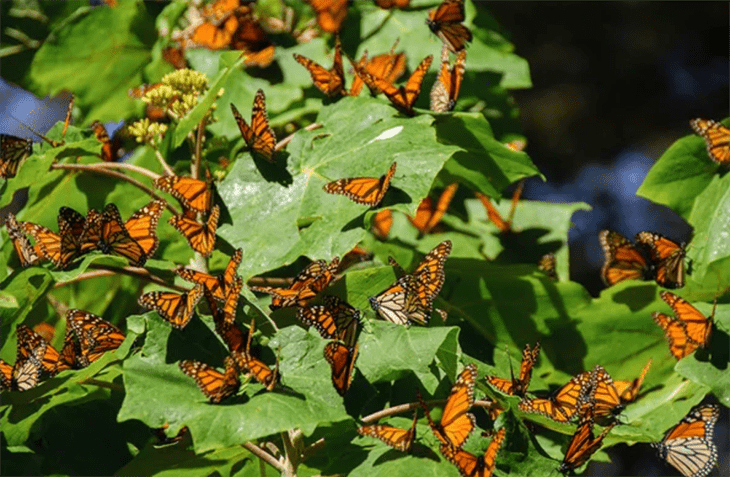

In a heartening development for environmentalists and nature lovers alike, the monarch butterfly population overwintering in Mexico has nearly doubled compared to the previous year.
According to the most recent census released by the World Wildlife Fund (WWF) in Mexico and their conservation partners, the iconic black-and-orange insects occupied 4.42 acres of forest in central Mexico during the winter of 2025—up significantly from 2.22 acres recorded the year before.
This dramatic increase in population has brought cautious optimism among scientists and conservationists who have been closely monitoring the eastern monarchs’ decline over recent decades. The annual survey, conducted in partnership with Mexico’s National Commission of Protected Natural Areas and local communities, remains one of the most vital tools for assessing the status of this migratory species.
“It’s now time to turn this year’s increase into a lasting trend with an all-hands approach where governments, landowners, conservationists, and citizens continue to safeguard critical habitats along the monarch’s North American migratory route,” said Jorge Rickards, director general of WWF Mexico, who recognized the key role of local communities and the government of Mexico in conserving the forest that provides an annual respite to this iconic species.
Scientists largely credit this year’s population surge to improved weather conditions along the monarchs’ migratory corridor, which stretches from southern Canada through the United States and down into the mountain forests of central Mexico. Unlike recent years, 2024 saw less severe drought, which enabled more butterflies to survive and complete their journey.
In addition to favorable weather, conservation efforts in Mexico’s overwintering sites appear to be paying off. A secondary report revealed that forest degradation within the Monarch Butterfly Biosphere Reserve—the butterflies’ main winter sanctuary—has dropped by 10 percent.
Between April 2023 and February 2024, only nine acres of forest were damaged, down from ten acres the year before. Causes of degradation ranged from illegal logging (6 acres) to natural conditions and drought (2.5 acres), and preventive tree removal due to disease (0.5 acre).
This modest but meaningful decline in deforestation reflects growing commitment to habitat protection. Still, experts urge that more must be done.
“If we want these butterflies to recover, they need more habitat restoration and better protection from pesticides,” said Emma Pelton, the western monarch lead for the Xerces Society. “They were proposed to be listed as threatened under the Endangered Species Act last December, and this listing urgently needs to be finalized.”
While this year’s numbers are promising for the eastern monarch population, which winters in Mexico, the picture remains less stable for western monarchs. These butterflies migrate along the Pacific Coast, primarily to overwintering grounds in California. After seeing population rebounds between 2021 and 2023, the western monarchs have declined again this year, demonstrating the volatile nature of monarch survival from year to year.
Over the last three decades, both eastern and western monarch populations have experienced dramatic fluctuations, influenced by habitat destruction, climate change, pesticide use, and the loss of native plants like milkweed. Even with recent gains, populations remain well below historic levels.
Despite the challenges monarchs face, individuals can play a meaningful role in their recovery. One of the simplest and most effective things you can do is plant milkweed—a native plant species that monarchs rely on exclusively to reproduce.
Milkweed is the only plant on which monarch butterflies will lay their eggs, and it provides the sole source of food for newly hatched caterpillars. As monarchs begin their journey north in the spring, they search for milkweed patches where they can start the next generation of their species.
Your backyard or garden can become part of a nationwide butterfly highway. If you’re considering planting milkweed, be sure to select a species native to your specific region, as certain types thrive better in different climates. Resources like regional milkweed planting maps can help you choose the right variety.
Adding nectar-rich flowering plants to your garden is another great way to support migrating monarchs, offering essential nourishment during their long travels.
The annual migration of the monarch butterfly remains one of nature’s most extraordinary phenomena. Every fall, these delicate insects travel up to 3,000 miles from their breeding grounds in Canada and the northern United States to their overwintering sanctuaries in Mexico’s mountain forests. But the adventure doesn’t stop there.
After spending the winter months in Mexico, these same butterflies begin the first leg of their return trip in spring, flying roughly 600 miles north to lay their eggs on milkweed plants in the southern United States. From there, a relay of three to five successive generations, each living only three to five weeks, continues the journey northward. Eventually, monarchs reach summer breeding grounds in southern Canada, completing the cycle and beginning it all over again.
What are your thoughts? Please comment below and share this news!
True Activist / Report a typo







